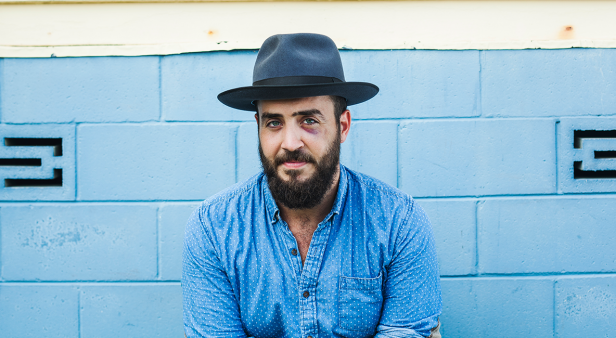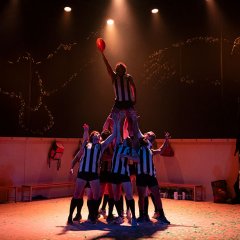Take us back to the beginning of your artistic journey! What was your first memorable encounter with the world of art?
I was lucky enough to be a finalist in the Archibald Prize, which in and of itself is a strange experience, but I remember feeling quite lost at the opening night, then feeling a tap on my shoulder and turning around to find myself face to face with the author Thomas Keneally. He said, “Hi I’m Tom! You must be that young artist I’ve been hearing about.” I can’t imagine he had heard anything good, but that moment has definitely stayed with me.
In the early days, what concepts and ideas did you use your budding artistic talents to explore?
When I first started looking into historical subject matter for my work, I made a whole series about JFK. I had always been deeply fascinated by his story and his role in history, so it was an amazing project to research and explore. I was able to visit the NASA archives at their headquarters in Washington D.C., and the JFK Presidential Library and Archives in Boston, where after one long day of research I was walking out as Caroline Kennedy was walking in. As she walked through the lobby she paused to stare intently at a recently installed photo of her parents standing beside a Christmas tree in the White House. I remember realising that these weren’t just abstract figures from history, but someone’s family. Someone’s mother and father. A lot of the things that I became interested in that early project have carried through to my practice today. I’m still very interested in not only historical content – historical figures and events – but how those narratives are constructed and communicated, especially in a post-internet environment.
What do you enjoy most about being able to work across a range of artistic disciplines?
I think what I find most rewarding and enjoyable about my approach to making work is that I can focus entirely on the concept behind a work – it isn’t simply defined by its medium. I love painting, drawing, sculpture, installation and video, but I love not being limited to any of them specifically. If I’m creating a series about a moment in time or a person, then I’m free to make whatever work feels right. I don’t have to worry about whether it’s consistent with the rest of my practice. Provided there’s a concept underpinning the work, it will all make sense in the end. I hope!
You draw material from various historical and contemporary figures and important events for your work – what happenings are currently informing your recent artistic practice?
At the moment I’m working on two different bodies of work – one for an exhibition later in the year and another for an exhibition next year. The first project is a series of paintings that are based on digital collages I’ve made using the different images I’ve amassed during years of research. Taking from the archive of thousands of images stored on my computer, I stitched together a series of images using all sorts of disparate imagery like ancient Greek and Roman sculpture, stock images of flowers, stars and constellations, as well as photographs from the NBA, the US space race, and different past and present military conflicts. The result is a series of colourful paintings that allude to some greater – albeit obscure – narrative. The other series is about a Greek architect and town planner, C.A. Doxiadis, who moved to Brisbane in the 1950s and was forced to farm tomatoes in Rochedale when he failed to have his qualifications recognised. When he eventually returned to Greece after his unsuccessful stint in Australia, he shot to fame almost instantly – working all over the world and eventually designing the city of Islamabad in Pakistan
We’re very excited to experience the pop-up installations taking place at Jacob’s Ladder and the Metro Arts laneway. What was it about this project that stirred your creative gears?
I think what interested me most about The Good Room’s project was the opportunity to use an inner-city Brisbane space – one that I pass through regularly on my way to and from work – to question ideas of nationality, and how nationality can shape personal identity. For me, this idea of what nationality means to an individual in an increasingly globalised world is an incredibly interesting one, and it’s something that I’m questioning in both my practice and my personal life. It seemed like a perfect opportunity to further my exploration into the life of C.A. Doxiadis and his struggles emigrating from Greece to Australia, as well as an opportunity to make work that explored the significance of my own heritage and to what extent I let my ancestry define me.
As the Brave New Worlds pop-up explores different visions of an ideal world, we’d love to know what sort of world would you most like to live in?
So much of my work relies on accessing information – often in very different ways, like through institutions and archives, the Internet, or even tracking down and speaking to people who were involved in different historical events. I often wonder what my work would look like in a different time or space – specifically how my work would change if I didn’t have access to the Internet or live in an age where the rest of the world is so accessible. I think access to information is the most empowering tool an individual can have, so my ideal world is one where that access is available to everyone – but perhaps one where that information is less corrupted, or at least not as easily tainted. A world without ‘fake news’, maybe.
What would you hope audiences take away from experiencing this project first hand?
What I’m hoping audiences will take away from my work specifically is a willingness to question their relationship with their own heritage – what nationality means to them, how it shapes their identity and their engagement with history, especially in a world where nationality and ideas of national identity are increasingly harder to define, and constantly in flux. But I’m also hoping they will come away with an eagerness to view their immediate surroundings as an important part of a much broader social and historical narrative. As Australians, we can often feel disconnected with the rest of the world – as if somewhere like Brisbane exists outside of history. We can feel like outsiders, looking in on the goings-on of the world. But Australia, and Brisbane specifically, is such a big part of an ongoing history and what happens around us has interesting and far-reaching effects on the world.
What do you like most about Brisbane’s artistic scene?
There is so much happening in Brisbane at the moment, it’s so hard to pin it down to one or two things. The gallery scene is so strong at the moment, with larger institutions like QAG|GoMA and the Museum of Brisbane constantly putting on important and world class exhibitions. Places like the Institute of Modern Art are so connected with some of the most important local and international art, and commercial galleries like Milani Gallery are constantly putting on beautiful and challenging exhibitions. I’m fortunate enough to have my studio in Metro Arts, which is an incredibly creative space that hosts artists, jewellers, performers and musicians, with an amazing roster of exhibitions by local and national artists. Brisbane is also full of dynamic artist-run initiatives as well. With long-running spaces like Boxcopy, as well as younger collectives like Cut Thumb Laundry and Fake Estate, there are so many opportunities for young artists to make interesting and thought-provoking work.
We’ve noticed through our covert Instagram stalking that you are a fan of plants! What’s the best aspect of your leafy addiction?
Well spotted! I am someone who is very prone to procrastination, so a few years ago when I started bring plants in to the studio it was a way of using the powers of procrastination for good instead of evil. They have been such a great stress reliever in the studio – they brighten up the space in a way that makes coming to work so rewarding. In the past I had gotten in to the habit of working seven days a week, but recently came to realise how important time off is for mental health and the creative process, so now my weekends are often spent at nurseries or gardening, or potting plants for my ever-growing studio collection. They have even started to creep into my work!
What are you currently finding inspiring about the world around you?
At the moment I’m getting inspiration from a lot of places! Like I mentioned earlier, the body of work about the Greek town planner who moved to Brisbane has been an endlessly fascinating project to work on. For my research I was able to travel to Athens to visit his archives, and I even managed to track down his daughter who is now in her seventies and lives on the island of Corfu. It has been interesting to hear about someone who tried to make a life for himself in Brisbane but was denied the opportunity to prosper due to something as trivial as not having the right qualifications. I think it’s an incredibly poignant and timely story, and I’m really looking forward to telling it.
I’ve also been more and more interested in finding different ways to source images for my drawings and paintings. Recently, I’ve started visiting the Wiki Commons website (an online database of free-use, community-sourced images) and hitting the “random file” button. It draws from tens of millions of images, and selects one totally at random so you end up with photographs of European castles, brand new passenger jets, Trump rallies, remote Russian farms, portraits of members of European parliament, and 18th century flower engravings. It’s quite fascinating! I’m thinking of using the randomly generated images I’ve collected so far for a future exhibition of paintings. I’m really liking how it removes any creative control and leaves things totally up to chance. But as the artist Martin Kippenberger said, “artists should have more ideas than time”, so we’ll see what I get to first!
Sam’s work is appearing in Brave New Worlds – a pop-up art installation by Brisbane art collective The Good Room from July 19–22. Sam is represented by Milani Gallery here in Brisbane, and Sophie Gannon Gallery in Melbourne.

